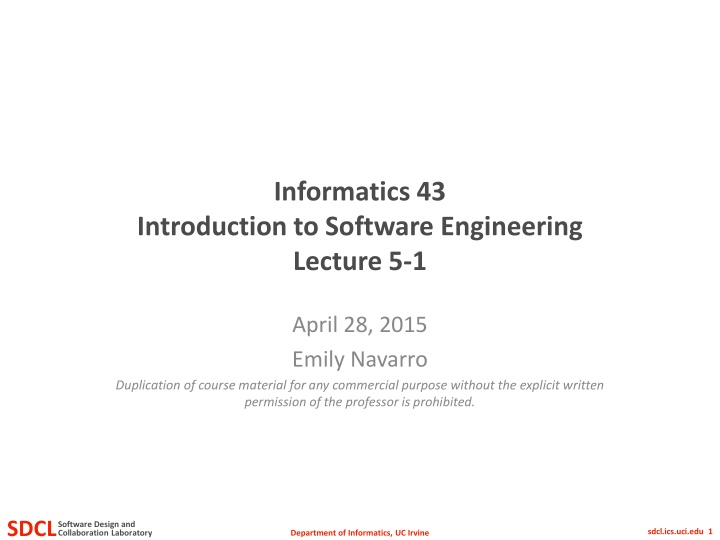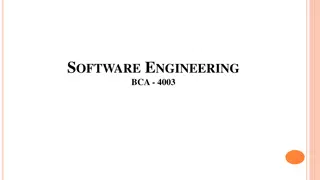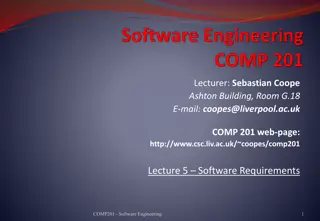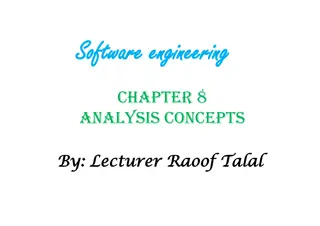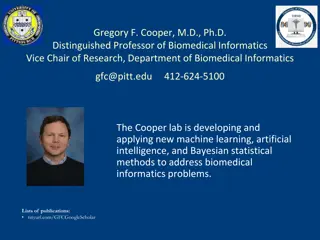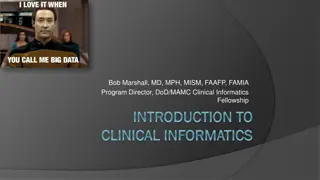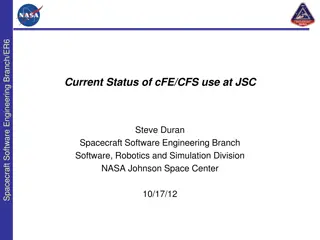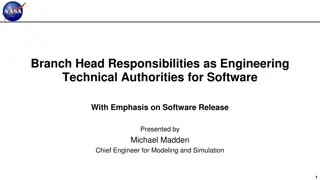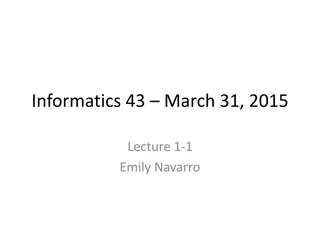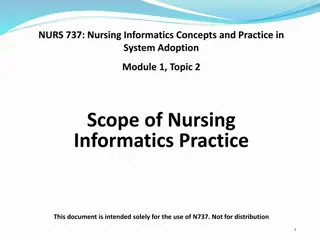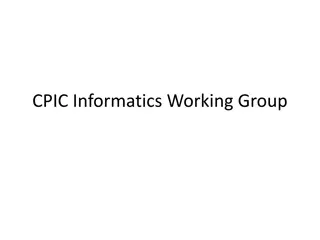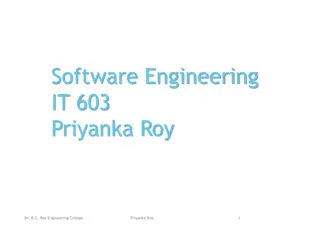Informatics 43 Introduction to Software Engineering Lecture 5-1
"This lecture covers the essential topics in software engineering, emphasizing the prohibition of duplicating course materials for commercial purposes without explicit permission. Gain insights into the foundations of software development and ethical practices."
Download Presentation

Please find below an Image/Link to download the presentation.
The content on the website is provided AS IS for your information and personal use only. It may not be sold, licensed, or shared on other websites without obtaining consent from the author.If you encounter any issues during the download, it is possible that the publisher has removed the file from their server.
You are allowed to download the files provided on this website for personal or commercial use, subject to the condition that they are used lawfully. All files are the property of their respective owners.
The content on the website is provided AS IS for your information and personal use only. It may not be sold, licensed, or shared on other websites without obtaining consent from the author.
E N D
Presentation Transcript
Informatics 43 Introduction to Software Engineering Lecture 5-1 April 28, 2015 Emily Navarro Duplication of course material for any commercial purpose without the explicit written permission of the professor is prohibited. SDCLCollaboration Laboratory Software Design and sdcl.ics.uci.edu 1 Department of Informatics, UC Irvine
Todays lecture Architectural styles Evolution Study guide for quiz 3 Some slides adopted and adopted from Software Architecture: Foundations, Theory, & Practice by Taylor, Medvidovic, and Dashofy SDCLCollaboration Laboratory Software Design and sdcl.ics.uci.edu 2 Department of Informatics, UC Irvine
Todays lecture Architectural styles Evolution Study guide for quiz 3 SDCLCollaboration Laboratory Software Design and sdcl.ics.uci.edu 3 Department of Informatics, UC Irvine
Defining software architecture A software system s architecture is the set of principal design decisions about the system Software architecture is the blueprint for a software system s construction and evolution Design decisions encompass every facet of the system under development structure behavior interaction non-functional properties SDCLCollaboration Laboratory Software Design and sdcl.ics.uci.edu 4 Department of Informatics, UC Irvine
Principal Principal implies a degree of importance that grants a design decision architectural status it implies that not all design decisions are architectural that is, they do not necessarily impact a system s architecture How one defines principal will depend on what the stakeholders define as the system goals SDCLCollaboration Laboratory Software Design and sdcl.ics.uci.edu 5 Department of Informatics, UC Irvine
Other definitions Fowler: The highest-level breakdown of a system into its parts; the decisions that are hard to change Bass, Clements, and Kazman: The structure or structures of a system, which comprises software elements, the externally visible properties of those elements, and the relationships among them Natar n: The clear definition of multiple high-level components that, when working together, form your system and solve your problem SDCLCollaboration Laboratory Software Design and sdcl.ics.uci.edu 6 Department of Informatics, UC Irvine
Software architectures elements A software system s architecture typically is not (and should not be) a uniform monolith A software system s architecture should be a composition and interplay of different elements processing data, also referred as information or state interaction components connectors SDCLCollaboration Laboratory Software Design and sdcl.ics.uci.edu 7 Department of Informatics, UC Irvine
Example configuration ship course procedure call procedure call procedure call ship radar GPS unit component connector SDCLCollaboration Laboratory Software Design and sdcl.ics.uci.edu 8 Department of Informatics, UC Irvine
Example configuration - simplified ship course ship radar GPS unit component connector SDCLCollaboration Laboratory Software Design and sdcl.ics.uci.edu 9 Department of Informatics, UC Irvine
Architectural style Certain design choices regularly result in solutions with superior properties compared to other possible alternatives, solutions such as this are more elegant, effective, efficient, dependable, evolvable, scalable, and so on An architectural style is a named collection of architectural design decisions that are applicable in a given development context constrain architectural design decisions that are specific to a particular system within that context result in beneficial qualities in each resulting system SDCLCollaboration Laboratory Software Design and sdcl.ics.uci.edu 10 Department of Informatics, UC Irvine
Architectural style A pattern of decisions that work well together A named, commonly used set of components and connectors Each component/connector has its own job in an architectural style SDCLCollaboration Laboratory Software Design and sdcl.ics.uci.edu 11 Department of Informatics, UC Irvine
Architectural style Victorian: Arts and Crafts: SDCLCollaboration Laboratory Software Design and sdcl.ics.uci.edu 12 Department of Informatics, UC Irvine
Architectural style? Jazz: Rock and Roll: SDCLCollaboration Laboratory Software Design and sdcl.ics.uci.edu 13 Department of Informatics, UC Irvine
Style 1: object-oriented ship course procedure call procedure call procedure call ship radar GPS unit component connector SDCLCollaboration Laboratory Software Design and sdcl.ics.uci.edu 14 Department of Informatics, UC Irvine
Style 1: object-oriented (simplified) ship course ship radar GPS unit component connector SDCLCollaboration Laboratory Software Design and sdcl.ics.uci.edu 15 Department of Informatics, UC Irvine
Style 1: object-oriented Components are objects Containing all the data and behavior relevant to the object Connectors are messages and method invocations Key benefits Objects expose a certain interface to other objects Abstraction An object s internal representation is hidden from other objects Anticipation of change Objects in software are used to model real-world objects Understandability Examples Business applications SDCLCollaboration Laboratory Software Design and sdcl.ics.uci.edu 16 Department of Informatics, UC Irvine
Style 2: model-view-controller ATM display rules back account SDCLCollaboration Laboratory Software Design and sdcl.ics.uci.edu 17 Department of Informatics, UC Irvine
Style 2: model-view-controller view ATM display controller rules model back account SDCLCollaboration Laboratory Software Design and sdcl.ics.uci.edu 18 Department of Informatics, UC Irvine
Style 2: model-view-controller Components are models, views, and controllers Models store information about the state of the program View components present information to the user Controllers allow user to control model/view and tell models (views) to update SDCLCollaboration Laboratory Software Design and sdcl.ics.uci.edu 19 Department of Informatics, UC Irvine
Style 2: model-view-controller Components are models, views, and controllers Models store information about the state of the program View components present information to the user Controllers allow user to control model/view and tell models (views) to update User interface User interface SDCLCollaboration Laboratory Software Design and sdcl.ics.uci.edu 20 Department of Informatics, UC Irvine
Style 2: model-view-controller Key benefits: Decouples model and view one model can support multiple views Decouples view and controller can change the way a view responds to user input Modularity, anticipation of change Examples Websites Web applications SDCLCollaboration Laboratory Software Design and sdcl.ics.uci.edu 21 Department of Informatics, UC Irvine
Style 3: client-server game client 1 game client 2 game client 3 remote call remote call remote call game server SDCLCollaboration Laboratory Software Design and sdcl.ics.uci.edu 22 Department of Informatics, UC Irvine
Style 3: client-server (simplified) game client 1 game client 2 game client 3 game server SDCLCollaboration Laboratory Software Design and sdcl.ics.uci.edu 23 Department of Informatics, UC Irvine
Style 3: client-server Components are clients and servers A server has computational resources that it provides to one or more clients Clients make requests of servers Generally used in distributed systems SDCLCollaboration Laboratory Software Design and sdcl.ics.uci.edu 24 Department of Informatics, UC Irvine
Style 3: client-server Key benefits Centralized security Centralized data access and management Examples email Web browser-based programs SDCLCollaboration Laboratory Software Design and sdcl.ics.uci.edu 25 Department of Informatics, UC Irvine
Style 4: layered SDCLCollaboration Laboratory Software Design and sdcl.ics.uci.edu 26 Department of Informatics, UC Irvine
Style 4: layered Components are organized in hierarchical layers Connectors are protocols of layer interaction Multi-level client server: each layer acts as a Service:service provider to layers above Client: service consumer of layer(s) below Key benefits Increasing abstraction levels Changes in a layer affect at most the adjacent two layers Anticipation of change Lower layers are easily reusable Examples Operating systems Networks SDCLCollaboration Laboratory Software Design and sdcl.ics.uci.edu 27 Department of Informatics, UC Irvine
Style 4: layered example Consider a supplier of tennis balls. It has several departments (in no particular order): Rolling: forms tennis balls from green ooze Assembly: puts balls into canisters Receiving: accepts shipments of canisters from Acme Canister Co. Packaging: packs filled canisters into cardboard boxes Inventory: stores parts SDCLCollaboration Laboratory Software Design and sdcl.ics.uci.edu 28 Department of Informatics, UC Irvine
Which department goes on the top layer of the company s manufacturing architecture? A.Rolling B.Assembly C.Receiving D.Packaging E.Inventory SDCLCollaboration Laboratory Software Design and sdcl.ics.uci.edu 29 Department of Informatics, UC Irvine
Which department goes on the top layer of the company s manufacturing architecture? A.Rolling B.Assembly C.Receiving D.Packaging E.Inventory SDCLCollaboration Laboratory Software Design and sdcl.ics.uci.edu 30 Department of Informatics, UC Irvine
Which department goes on the second layer of the company s manufacturing architecture? A.Rolling B.Assembly C.Receiving D.Packaging E.Inventory SDCLCollaboration Laboratory Software Design and sdcl.ics.uci.edu 31 Department of Informatics, UC Irvine
Which department goes on the second layer of the company s manufacturing architecture? A.Rolling B.Assembly C.Receiving D.Packaging E.Inventory SDCLCollaboration Laboratory Software Design and sdcl.ics.uci.edu 32 Department of Informatics, UC Irvine
Which department goes on the third layer of the company s manufacturing architecture? A.Rolling B.Assembly C.Receiving D.Packaging E.Inventory SDCLCollaboration Laboratory Software Design and sdcl.ics.uci.edu 33 Department of Informatics, UC Irvine
Which department goes on the third layer of the company s manufacturing architecture? A.Rolling B.Assembly C.Receiving D.Packaging E.Inventory SDCLCollaboration Laboratory Software Design and sdcl.ics.uci.edu 34 Department of Informatics, UC Irvine
Which department goes on the fourth layer of the company s manufacturing architecture? A.Rolling B.Assembly C.Receiving D.Packaging E.Inventory SDCLCollaboration Laboratory Software Design and sdcl.ics.uci.edu 35 Department of Informatics, UC Irvine
Which department goes on the fourth layer of the company s manufacturing architecture? A.Rolling B.Assembly C.Receiving D.Packaging E.Inventory SDCLCollaboration Laboratory Software Design and sdcl.ics.uci.edu 36 Department of Informatics, UC Irvine
Style 4: layered example The tennis ball supplier s organization can be viewed as having a layered architecture: TOP: Packaging: packs filled canisters into cardboard boxes Assembly: puts balls into canisters Inventory: stores parts BOTTOM Receiving: accepts shipments of canisters from Acme Canister Co. Rolling: forms tennis balls from green ooze SDCLCollaboration Laboratory Software Design and sdcl.ics.uci.edu 37 Department of Informatics, UC Irvine
Style 5: peer-to-peer skype 1 stream stream skype 2 stream skype 3 SDCLCollaboration Laboratory Software Design and sdcl.ics.uci.edu 38 Department of Informatics, UC Irvine
Style 5: peer-to-peer (simplified) skype 1 skype 2 skype 3 SDCLCollaboration Laboratory Software Design and sdcl.ics.uci.edu 39 Department of Informatics, UC Irvine
Style 4: peer-to-peer Components ( peers ) are equals and can act as either clients or servers Data and behavior are distributed among peers Connectors are network protocols Key benefits Highly robust in the face of failure of any given node Examples File sharing systems, Skype SDCLCollaboration Laboratory Software Design and sdcl.ics.uci.edu 40 Department of Informatics, UC Irvine
Style 6: pipe-and-filter print records stream sort stream remove duplicates SDCLCollaboration Laboratory Software Design and sdcl.ics.uci.edu 41 Department of Informatics, UC Irvine
Style 6: pipe-and-filter Components are filters Transform input data streams into output data streams Connectors are pipes Conduits for data streams Key benefits Easy filter addition, replacement, and reuse Possible to hook any two filters together Examples UNIX shell ls invoices | grep -e August | sort SDCLCollaboration Laboratory Software Design and sdcl.ics.uci.edu 42 Department of Informatics, UC Irvine
Style 7: publish-subscribe (pub-sub) trader 2 trader 1 trader 3 remote call remote call stream remote call stock market SDCLCollaboration Laboratory Software Design and sdcl.ics.uci.edu 43 Department of Informatics, UC Irvine
Style 7: pub-sub Components are publishers or subscribers Subscribers register/deregister to receive specific messages/content Publishers broadcast messages to subscribers Connectors are network protocols Key benefits Efficient one-way dissemination of information Scalability Examples Stock market News SDCLCollaboration Laboratory Software Design and sdcl.ics.uci.edu 44 Department of Informatics, UC Irvine
Mixing styles is often necessary trader 2 trader 1 trader 3 remote call remote call stream remote call stock market server procedure call purchasing rules procedure call procedure call stock database SDCLCollaboration Laboratory Software Design and sdcl.ics.uci.edu 45 Department of Informatics, UC Irvine
Todays lecture Quiz Answers Architectural styles Evolution Quiz 3 SDCLCollaboration Laboratory Software Design and sdcl.ics.uci.edu 46 Department of Informatics, UC Irvine
Todays lecture Architectural styles Evolution Study guide for quiz 3 SDCLCollaboration Laboratory Software Design and sdcl.ics.uci.edu 47 Department of Informatics, UC Irvine
Back to evolution Essential part of software development Must be accommodated as much as possible Must be planned as much as possible SDCLCollaboration Laboratory Software Design and sdcl.ics.uci.edu 48 Department of Informatics, UC Irvine
Back to evolution Essential part of software development Must be accommodated as much as possible Must be planned as much as possible Architecture is a key tool in accommodating evolution SDCLCollaboration Laboratory Software Design and sdcl.ics.uci.edu 49 Department of Informatics, UC Irvine
Accommodating change ATM display procedure call rules procedure call procedure call back account New overdraft rule? SDCLCollaboration Laboratory Software Design and sdcl.ics.uci.edu 50 Department of Informatics, UC Irvine
